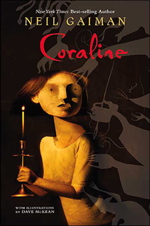Scary stories
Emily, 14, says that if a scary movie isn’t your style, then get an old school fright with the novel Coraline.

Title: Coraline
Author: Neil Gaiman
Illustrator: Dave McKean
By Emily Clarke, 14, Palisades Charter HS
After picking up Coraline on a whim when I couldn’t sleep one night, I learned that buttons are infinitely scarier than, say, zombies. Or, at least they are after you’ve read Coraline, a book about corrupted wishes and the willingness to believe that there’s another world at your fingertips.
Coraline is the story of a 10-year-old girl who moves with her parents to a new house and discovers a door that opens to a brick wall. However, strange things happen when she opens it for the second time—she is faced with an apartment like her own, but not quite. An “Other” mother and father greet Coraline. They are different from her real parents; they have buttons for eyes, and they devote attention to her. Her real parents are so immersed in their work they cannot be bothered by anyone. When Coraline goes back to the “real” world, her parents are missing. She looks in a large mirror and they are trapped in the mirror, mouthing words she can’t hear. Coraline’s mother writes “HELP US” backwards with her finger on the mirror. Coraline waits in the real apartment for days, hoping they’ll come back.
When they don’t, she decides to walk through the door again, and this time she is not enchanted with her Other parents who will do anything for her. As she learns more about the alternate apartment, the Other parents become more and more crooked, wanting her to stay on their side in a desperate, twisted way. Coraline has to find a way to escape the long, spidery, sharp fingers of her Other mother, who controls the world around her like it is her canvas and she is a painter, and doesn’t allow Coraline to leave. So Coraline explores the new world in hopes of finding a way to save her parents.
In the end, Coraline hasn’t changed. She is still the compassionate, brave heroine. But she appreciates her family; her faith in them has grown.
There is nothing creepier than reading this book at night when you’re the only one up. The conversations are dream-like and the illustrations of the sketchy, thin, paper-white people in the Other world add to the haunting imagery in the text. Through it all, Coraline remains calm, sensible and courageous, in comparison to me, shivering and reading with eyes wide open. It was especially chilling when Coraline first goes to the Other world and says, “I didn’t know I had another mother,” to which the woman says, “Of course you do. Everyone does.”
This book will leave you wondering just what sort of dreams you’ll have when you let yourself go to sleep. I would recommend this book. It is, as Neil Gaiman says he wanted it to be, “refreshingly creepy.”


